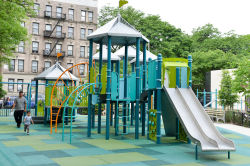Saw Mill Playground
Saw Mill Playground
What was here before?
Saw Mill Playground lies in the heart of the Mott Haven section of the Bronx. In the 1840s, Jordan L. Mott (1798-1866) purchased 200 acres of lower Morrisania, where he laid out lots for purchase and renamed the area after himself. Mott was a prodigious inventor and entrepreneur, and from age 15 earned over fifty patents in his lifetime. He opened an iron foundry, J.L. Mott Iron Works, in Lower Manhattan in 1928, which produced manhole covers for the Bronx, wrought-iron bridges for Central Park, and decorative ironwork used internationally. Foundry operations relocated to Mott Haven along the Harlem River in the 1840s before moving to Trenton, NJ in 1902.
How did this become a playground?
NYC Parks acquired the site for Saw Mill Playground in October 1964. The property is a Jointly Operated Playground (JOP) serving Public School 49 (now the Young Leaders Academy) and the local community. Beginning in 1938, the Board of Education agreed to provide land next to schools where NYC Parks could build and maintain playgrounds that could be used by the school during the day and the public on evenings and weekends. The first stage of construction was completed in 1968, and further improvements in 1969 provided more play space. After additional renovations, the playground opened to the public on October 11, 1974. It was named Saw Mill Playground in 1987.
This site is part of Parks' Community Parks Initiative, a multi-faceted program to invest in under-resourced public parks and increase the accessibility and quality of parks throughout the five boroughs. Through this program, Saw Mill Playground received a new multipurpose court area, synthetic turf field and track, spray showers, and a public restroom in 2019.
What is this playground named for?
This playground is named for the Saw Mill Creek, also known as the Mill Brook, which once flowed by this playground. Originating in Gates Place in the North Bronx, it ran along what is now Brook and Webster Avenues and emptied into the Bronx Kill, a narrow strait that connects to the Harlem River. Sawmills flourished along the Bronx’s many tributaries for over two hundred years. Early sawmills were dependent on water as both a power source and a means of transporting goods. Logs floated downriver to sawmills to be cut into standardized shapes and sizes for building purposes. Wood pulp, used to make paper, was another byproduct of the sawing process. Due to the abundance of lumber and waterpower in the Hudson River Valley, sawmills became a lucrative industry for 17th-century European settlers.
Adriaen van der Donck constructed the first sawmill in this area around 1650. Located on a creek on the northern end of his property, which stretched from the Spuyten Duyvil Creek (dividing the Bronx from Manhattan) to present-day Yonkers, van der Donck’s mill cut logs to build ship masts. The region’s most famous sawmill belonged to Jacobus Van Cortlandt, Mayor of New York from 1710 to 1719., Van Cortlandt dammed Tibbett’s Brook in the 1690s to form Mill Pond, now known as Van Cortlandt Lake, and built both a sawmill and a gristmill to grind grain. By 1889 when Van Cortlandt’s mills closed, steam power made water-powered, colonial-era sawmills nearly obsolete.
Check out your park's Vital Signs
Clean & Safe
Green & Resilient
Empowered & Engaged Users
Share your feedback or learn more about how this park is part of a
Vital Park System






